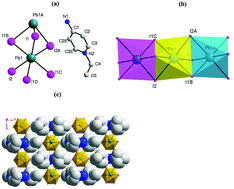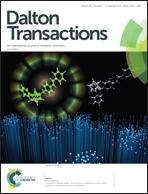An inorganic–organic hybrid crystal with a two-step dielectric response and thermochromic luminescence†
Abstract
An iodoplumbate-based hybrid crystal [C2-Apy][PbI3] (1) (C2-Apy+ = 1-ethyl-4-aminopyridinium) was synthesized and characterized structurally. Single crystal X-ray diffraction revealed that 1 crystallizes in the orthorhombic system with the space group Pnma at 150 K. Inorganic components form straight and face-sharing octahedral [PbI3]∞ chains and organic components form C2-Apy+ cations that are incorporated into the space between the inorganic chains. A temperature-dependent single crystal structure indicates that there exists an order–disorder transition of the cation. The dynamic motion of the cation strongly influences the dielectric and emission features of 1. 1 shows a two-step dielectric response. The first step dielectric response at a low frequency is caused by direct current conduction and electrode polarization which have been proved by impedance spectra. The second dielectric response at a high frequency (10 kHz to 10 MHz) is related to the order–disorder transition of the alkyl chain and the dynamic motion of pyridyl rings. In addition, 1 shows multi-band emission, and different emission bands show different trends with the temperature change, which makes 1 exhibit thermochromic luminescence properties.



 Please wait while we load your content...
Please wait while we load your content...